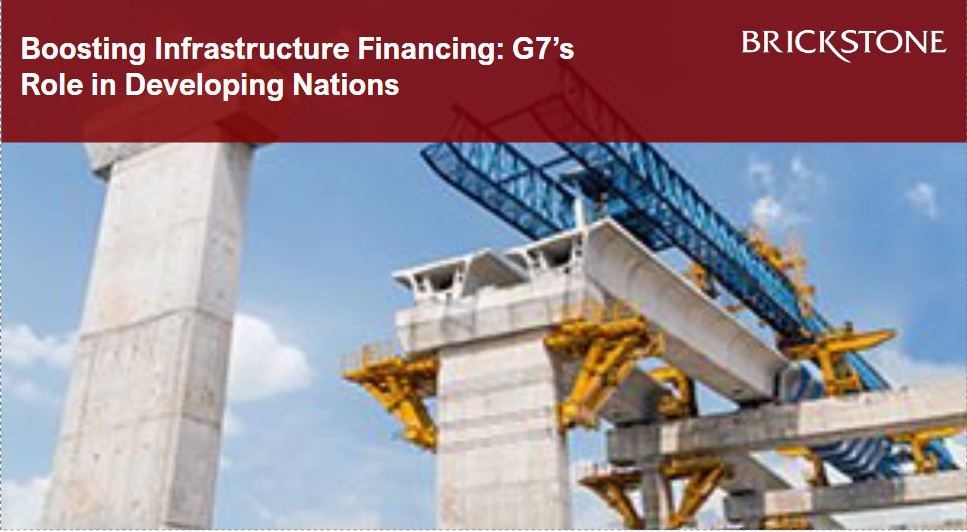Boosting Infrastructure Financing: G7’s Role in Developing Nations
Boosting Infrastructure Financing: G7’s Role in Developing Nations
The document Scaling-up Financing for Infrastructure in Developing Countries: What Can the G7 Do? provides an extensive exploration of how infrastructure financing can be enhanced in developing countries. It highlights the challenges faced by these nations in securing sufficient funding for infrastructure projects and the critical role that the G7 can play in addressing these gaps. With the global infrastructure financing gap widening, particularly in regions like Sub-Saharan Africa, the document outlines policy proposals and mechanisms that could help bridge these gaps and accelerate sustainable development.
The report begins by noting that infrastructure plays a pivotal role in achieving the Sustainable Development Goals (SDGs), directly or indirectly impacting 121 of the 169 targets. Investments in infrastructure—especially climate-resilient and sustainable projects—are highlighted as essential for economic growth and job creation. For example, the paper cites that every dollar invested in climate-resilient infrastructure in developing countries can yield economy-wide returns of four dollars. Despite these returns, the financing gap for infrastructure in developing nations remains substantial, with Sub-Saharan Africa requiring investments equivalent to 9.2% of its GDP, compared to regions like South Asia and Latin America, where the needs are slightly lower.
One of the core challenges identified is the perception of infrastructure investments as high-risk ventures. Global capital fund managers and institutional investors often view infrastructure projects in developing countries as fraught with risks such as project delays, cost overruns, and political interference. The paper mentions that about 80% of infrastructure projects in Africa fail at the feasibility and planning stages due to these risks, further complicating efforts to secure financing. Additionally, the lack of publicly available information on successful projects and the strengths or weaknesses of local ecosystems makes it difficult for investors to assess risk accurately. This situation is exacerbated by the limited capacity of governments in developing countries to structure and execute Public-Private Partnerships (PPPs), which are often necessary for large-scale infrastructure projects.
The paper also discusses the challenge of bringing projects to “bankability,” meaning the point at which they are deemed financially viable by private investors. Many high-impact infrastructure projects, especially those with significant social or environmental benefits, do not necessarily generate the financial returns that traditional investors seek. To attract private finance, project owners need to integrate impact indicators related to environmental, social, and economic resilience into their project assessments. The proliferation of Environmental, Social, and Governance (ESG) frameworks, while helpful, has led to confusion, as many of these frameworks are inconsistent or difficult to apply in developing countries.
Blended finance, a mechanism that combines public and private capital to de-risk investments in infrastructure, is presented as a critical solution to these challenges. Since its inception at the UN Third International Conference on Financing for Development in 2015, blended finance has mobilized nearly $213 billion for sustainable development in developing countries. However, the report points out that despite this success, blended finance has not lived up to its full potential, largely due to the complexities involved in structuring these deals and the lack of standardization across projects.
The document highlights the role of the G7 in addressing these infrastructure financing challenges. The G7’s Partnership for Global Infrastructure and Investment (PGII), launched in 2022, aims to mobilize up to $600 billion by 2027 to narrow the infrastructure investment gap in developing countries. Through this partnership, the G7 is positioned to work with key actors, including multilateral development banks (MDBs), development finance institutions (DFIs), and private investors, to create a pipeline of bankable infrastructure projects in these regions. The focus for the G7 in 2024, under Italy’s presidency, is on Africa and its sustainable infrastructure needs. The paper underscores the importance of leveraging existing initiatives, such as the African Union’s Programme for Infrastructure Development in Africa (PIDA), which has developed quality standards for infrastructure projects, including metrics on job creation, climate resilience, and social inclusiveness.
The paper puts forward three key policy recommendations for the G7 to enhance infrastructure financing in developing countries:
- Tackling Information Gaps: The G7 should work to make information on project pipelines more publicly available, allowing investors to better assess the risks and rewards of infrastructure projects. This involves creating detailed records of successful projects and the factors that contributed to their success. For instance, the report notes that Africa boasts the world’s lowest cumulative default rates on infrastructure projects, suggesting that investments in the region could be less risky than perceived.
- Establishing a G7 PGII Project Preparation Facility: To ensure that high-impact infrastructure projects are brought to market, the G7 could create a dedicated project preparation facility. This would provide design-stage grants, guarantees, and capacity-building initiatives to ensure that projects are properly structured and viable before seeking private finance. The document emphasizes that design-stage funding is crucial for conducting feasibility studies and proof of concept, which are often missing in early-stage infrastructure projects in developing countries.
- Providing Direct Concessional Capital: The G7 should consider providing direct concessional capital for transformative infrastructure projects in developing countries. These projects, particularly those in Africa, require significant upfront investments to achieve the necessary scale for private investment. The document suggests prioritizing the 69 projects listed in the PIDA 2021–2030 implementation plan, which are seen as having strong national and regional commitment.
In conclusion, the document Scaling-up Financing for Infrastructure in Developing Countries provides a detailed analysis of the challenges and opportunities for financing infrastructure in the developing world. It emphasizes the importance of blended finance, risk mitigation, and public-private partnerships in overcoming these challenges and highlights the critical role the G7 can play in mobilizing capital for infrastructure development. By addressing information gaps, supporting project preparation, and providing direct concessional capital, the G7 can help bridge the infrastructure financing gap in developing countries, particularly in Africa.
This article by Brickstone reviews Think 7 publication on scaling-up financing for infrastructure in developing countries what can G7 do?
Read the complete publication here.
.





